#Quiet SuperSonic Technology
Explore tagged Tumblr posts
Text
NASA Targets 2024 for First Flight of X-59 Experimental Aircraft
https://enterprisewired.com/wp-content/uploads/2023/10/NASA-Targets-2024-for-First-Flight-of-X-59-Experimental-Aircraft.jpg
Share Post:
LinkedIn
Twitter
Facebook
Reddit
NASA’s Quesst mission has postponed the inaugural flight of its X-59 quiet supersonic aircraft to 2024. The X-59, an extraordinary experimental aircraft, has posed intricate engineering challenges for NASA researchers collaborating with the primary contractor, Lockheed Martin Skunk Works. Apart from its unique design, the X-59 incorporates innovative technology and components from various established aircraft, including its landing gear from an F-16 and its life-support system adapted from an F-15.
Additional time is required to integrate systems into the aircraft
Given the complexities involved in developing this exceptional aircraft, the Quesst team is diligently addressing several technical issues identified during the course of 2023, when the X-59 was initially slated for its maiden flight. Additional time is required to seamlessly integrate systems into the aircraft and ensure their proper functioning. The team is also resolving intermittent problems with some of the safety-redundant computers that oversee the aircraft’s systems.
Over the past year, Quesst has made consistent progress towards flight readiness. The team completed the finishing touches on the X-59’s tail structure, allowing them to finalize its electrical wiring and advance to critical ground tests. They also moved the aircraft from its assembly facility to the flight line for structural testing.
The X-59’s primary objective is to demonstrate the capability to achieve supersonic flight, exceeding the speed of sound, while minimizing the typical disruptive sonic boom to a subdued sonic thump. NASA intends to conduct flights over several communities to collect data on how people perceive the noise it generates. This data will be provided to U.S. and international regulators to potentially revise regulations that currently prohibit commercial supersonic flight over land.
Lockheed Martin X-59 finally unveiled in hangar rollout
youtube
Fully committed to a meticulous review and testing process
NASA places paramount importance on safety and mission success. For Quesst, this entails ensuring the X-59’s safety before it takes flight and ensuring its long-term reliability during the community test phase. The aircraft is currently undergoing comprehensive integrated testing, which must be successfully completed prior to its inaugural flight. Following this stage, the aircraft will proceed to a flight readiness review, during which NASA will unveil a more specific timeline for the first flight.
Quesst represents a mission with the potential to transform commercial aviation travel by significantly reducing travel times. Safely and reliably deploying the X-59 is crucial for NASA to realize the benefits of this mission. The agency is fully committed to a meticulous review and testing process to ensure the mission’s success.
Read More: New Asteroid Search Algorithm Detects Its First Dangerous Space Rock
20 notes
·
View notes
Text
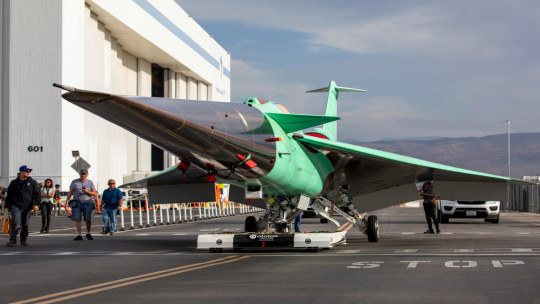
NASA postpones X-59 flight tests to 2024
Fernando Valduga By Fernando Valduga 10/20/2023 - 10:01am in Technology
NASA postponed the first flight of the X-59 low-noise supersonic demonstrator to 2024, after a series of subsystem problems found during verification tests at Lockheed Martin's Skunk Works facility in Palmdale, California, later this summer, proved more difficult to solve than expected.
"We want to fly as early as possible, but we want to fly safely," says the agency, which - together with Lockheed Martin - has solved a variety of problems of abandonment and redundancy of security systems in various subsystems.
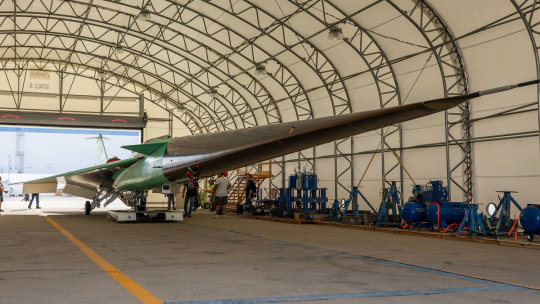
First reported in August, the problems are related to the flight control computer and the hydraulic system and were found during structural coupling tests in Palmdale. The coupling tests were designed to evaluate the interaction between the fuselage and the flight control system, and to ensure the absence of any aeroelastic and aeroservoelastic instabilities.
Developed by Lockheed for NASA's Quiet Supersonic Technology (QueSST) program, the X-59 almost 30 meters long was originally supposed to fly in 2021. However, the latest system-related delays add to a series of delays that included workforce hiring issues, the pandemic and technical challenges related to cabling and the integration of final systems. Until recently, the agency still expected to make the first flight of the X-59 by the end of the year, with a transition soon after to NASA's neighboring Armstrong Flight Research Center at Edwards Air Base for subsequent expansion of the envelope.

Commenting on the delay, NASA states: “This unique experimental aircraft requires unique and complex engineering, and its team encountered several technical challenges last year. The X-59 is currently in the process of integrated testing, which must be completed to help ensure safe and successful flights. NASA plans to release a more specific schedule for the first flight when the flight readiness review is completed, after integrated tests."
The X-59 is designed to collect community response data on the public acceptability of reduced sonic rons. The data will be used by U.S. and international authorities to determine whether a growth standard can be established that allows the release of the current ban on civilian supersonic flights over land, which has been in force since the 1970s.
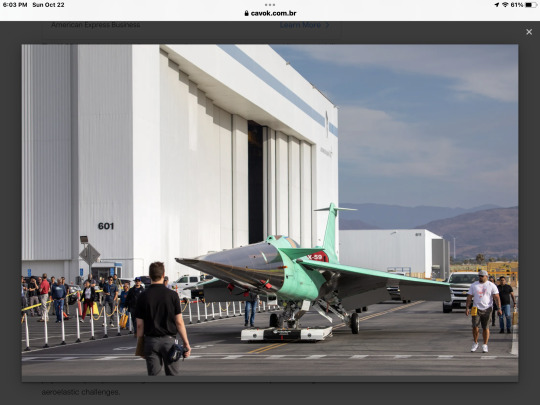
However, to achieve low-intensity sonic sonic roning at the projected speed of the X-59 of Mach 1.4, the aircraft is configured with a well-sloping hang glider and swinging extended nose section that represents more than one third of the length of the vehicle. Specifically designed with rigidity for high-speed testing, rather than resistance for payload capacity, the long and slender format therefore presents significant aeroelastic challenges.
Source: Aviation Week
Tags: Lockheed MartinNASAQueSST - Quiet Supersonic TechnologyTechnologysupersonic flightX-59
Sharing
tweet
Fernando Valduga
Fernando Valduga
Aviation photographer and pilot since 1992, has participated in several events and air operations, such as Cruzex, AirVenture, Dayton Airshow and FIDAE. He has work published in specialized aviation magazines in Brazil and abroad. Uses Canon equipment during his photographic work in the world of aviation.
Related news
MILITARY
Philippine Air Force acquires Lockheed C-130J-30 Super Hercules aircraft
19/10/2023 - 22:41
Bombardier solidifies its leading position in sustainable aviation and continues its work of defining the industry in the EcoJet research project, accelerating the second phase of testing.
TECHNOLOGY
Bombardier accelerates second phase of testing of the EcoJet research project
17/10/2023 - 16:00
Lockheed Martin received a contract from the U.S. Navy to build eight MH-60R helicopters Seahawk for the Spanish Navy. In the photo, a U.S. Navy MH-60R aircraft.
HELICOPTERS
Lockheed Martin receives contract to manufacture eight MH-60R Seahawk helicopters for the Spanish Navy
15/10/2023 - 20:05
HELICOPTERS
VIDEO: Airbus demonstrates single piloting joystick to replace three helicopter pilot controls
13/10/2023 - 13:00
Boeing ecoDemonstrator Explorer, a United Airlines 737-10, will fly in SAF, followed by NASA's DC-8 Airborne Science Lab measuring non-CO2 emissions.
COMMERCIAL
Boeing, NASA and United Airlines will test SAF benefits with flight formations of a DC-8 and a 737-10
13/10/2023 - 08:02
EVTOL
Boeing's Wisk Aero starts new flight tests with its eVTOL in Los Angeles
09/10/2023 - 11:00
10 notes
·
View notes
Text
NASA X-59: Quiet Supersonic Jet Nears First Flight After Tests
NASA X-59 Supersonic Jet Moves Closer to First Flight NASA’s experimental X-59 supersonic jet has taken a major step toward its inaugural flight, with the successful completion of its maximum afterburner engine test. This marks a significant milestone in the development of the Quiet SuperSonic Technology (QueSST) program aimed at reducing the disruptive sonic booms of supersonic travel. Engine…
0 notes
Text
NASA to Test Technology for X-59s Unique Shock Wave Measurements
NASA will soon test advancements made on a key tool for measuring the unique “sonic thumps” that its quiet supersonic X-59 research aircraft will make while flying. A shock-sensing probe is a cone-shaped air data probe developed with specific features to capture the unique shock waves the X-59 will produce. Researchers at NASA’s Armstrong Flight […] from NASA https://ift.tt/SoVMRIQ
0 notes
Text
NASA, Uçuşlarda Gürültüyü Asgariye İndiren Süpersonik Uçağı X-59'un Motorunu İlk Kez Çalıştırdı! (Yüksek İrtifada Sessiz Uçuş Mümkün mü?)
NASA, süpersonik uçuşları daha sessiz hale getirecek X-59 uçağının motorlarını ilk kez çalıştırdı ve test etti. NASA, sessiz süpersonik X-59 uçağının motorlarını ilk kez çalıştırdı. X-59, ses patlamalarını minimum seviyeye indirerek süpersonik uçuşları daha sessiz hale getirmeyi amaçlıyor. NASA’nın X-59 uçağı, Quiet Supersonic Technology (Quesst) adı verilen bir teknoloji ile tasarlandı.…
0 notes
Video
youtube
R5 High Speed Hair Dryer Factory Wholesale High Quality LCD High Speed H...
R2 High Speed Hair Dryer: Your Ultimate Hair Care Companion
Introducing the R2 High Speed Hair Dryer, an innovative styling tool designed for fast, efficient, and healthy hair drying!
Powerful Performance
Rated Power: 1500W Wind Speed: 22m/s Motor Speed: 110,000 RPM With these specs, you can dry your hair in record time without sacrificing care or shine! Whisper-Quiet Operation
Noise Level: Only 65dB Enjoy a peaceful drying experience, making it the perfect companion for any time of the day. Advanced Hair Care Technology
Negative Ions: 200 million negative ions help to reduce frizz and enhance shine, giving your hair a silky and smooth finish. Constant Temperature: Keeps the temperature at a safe 100°C to effectively prevent heat damage, ensuring your hair remains healthy and vibrant. User-Friendly Features
LED Display: A full-color digital screen displays settings clearly, while the outer ring features a three-color light indicator for a modern touch. Dual Magnetic Suction: The included magnetic nozzle and air intake net provide convenience and versatility in styling. Specifications
Cable Length: 1.8 meters with a single air nozzle Color Options: Available in Pink, White, Silver Grey, and Navy Blue (custom colors available upon request). Smart Design for Durability The R2 is equipped with an imported bearing motor designed for longevity, so you can enjoy effective drying power for years to come. With two-speed settings, you can easily adjust the airflow to suit your styling needs.
Transform your hair routine with the R2 High Speed Hair Dryer! Ready to elevate your styling game? Click the link to purchase R2 High Speed Hair Dryer: https://www.teejoiniot.com/product/high-speed-digital-display-blow-dryer
Unlock the secret to gorgeous, healthy hair with the R2 Hair Dryer today!
#highspeed #hairdryer #highspeedhairdryer #haircare #smartappliances #supersonic #bldcmotor #haircareproducts #hairstyle #hairstyles #TeejoinHairdryer #hairdryerOEM #hairDryerODM #homestyle #besthairdryer #professionalhairdryer #salon #shorts_video #HairCare #hairandmakeup #hairstyles #hairstylingtools #blowdry #hairdryer #hairstyler #hairstylingtools #factory #hairtools #hairdrying #haircareproducts #hairdryerandstyler #HairDryerOem #HairDryerODM #hairstyle #hairbeauty #hairdryers #S5HairDryer #HairDryerS5 #hairdryerfactory #manufacturer #manufacturerprice #chinafactory #futuretech #R2HairDryer #R2HighSpeedHairDryer
0 notes
Text
Price: [price_with_discount] (as of [price_update_date] - Details) [ad_1] From the manufacturer Faster Cooling With the Supersonic Cooling Mode, wait no more for the AC to activate. With this functionality, the AC begins to cool the room within 10 seconds of switching it on. Beat your stressful and humid days with this AC’s unbeatable cooling prowess. Quiet Mode To enjoy a peaceful night's sleep, you can always choose to switch off the temperature indicating light on the AC and to take it a step further, the quiet operation mode ensures peace of mind all through the night Twin Inverter Enjoy efficient, comfortable, and reliable cooling with Twin Inverter+ which saves upto 65% energy and also ensures optimal efficiency at multiple frequencies and voltage ranges. Long Air Flow Ensure even cooling up to 20 meters with Long Distance Air Flow technology, providing consistent comfort and minimizing hot spots.
54 Degree Cooling at Extreme Temperature This AC can cool efficiently even in outside weathers up to 54°C, providing high ambient cooling and reliable performance even during the harshest summers. 100 % Grooved Copper Experience efficient cooling, long-lasting durability and superior performance with 100% Grooved Copper technology, with pipes having inner grooves for an increased heat exchange efficiency up to 50%. Super Anti Corrosion Anti-Corrosion Technology protects your AC from rust and corrosion using a plastic grill, high level cover coating and protection lacquer coating for long-lasting performance and durability. R-32 Gas The addition of R-32 refrigerant comes to you as a savior as it aids in friendly cooling Split AC with Twin Inverter Compressor: Variable speed compressor which adjusts power depending on heat load. With 5 in 1 user can control the cooling capacity as per requirement (40% to 110% Capacity) and saves upto 60% more energy compares to other air conditioners. Capacity: 1 Ton; 3400 watts. Suitable for small sized rooms ( up to 110 sq.ft) | Air Circulation: 700 CFM | 54°C high ambient performance which give you optimum cooling even in the hottest days Energy Rating: 3 Star | ISEER: 3.85 | Annual Energy Consumption: 680 KWH | Refrigerant: R32 Refrigerant has been used which is environment friendly and has No Ozone Depletion Potential and Low Global Warming Potential Manufacturer Warranty: 1 Year comprehensive warranty on Product* and 12 Years Warranty on Compressor Copper Condenser Coil: 100% Pure Grooved Copper helps compressor to provide better cooling, avoid unexpected damages and have longer life. Special Features: Hyper PCB - with thicker conformal and FR4 flame resistance material | Grooved Cooper Coils | Super Micro Antibacterial Filter | Anticorrosive Coating for more durability and longer life 54°C High Ambient Performance: Special design and effective conformal coating protects the components and helps maintain the cooling even at 54°C temperature. Super Micro Anti-Bacterial Filter: Protect your family from Dust, Bacteria and Pet Danger to give safe indoor environment to your loved ones Item Dimensions & Weight: Indoor Unit IDU (l*b*h cms)- 86.5*20*29 Weight (Kg)- 12 | Outdoor Unit ODU (l*b*h cms)- 78*29.5*54.5 Weight (Kg)- 22 Included in the box: 1 Indoor Unit | 1 Outdoor Unit | Remote Controller | Copper Tube wrapped with Poly-E-Foam (Length: 3 mtrs) | Interconnecting Power Supply Cord (Length: 3.5 mtrs) | User Manual | Warranty Card [ad_2]
0 notes
Text
Study shows robotic third thumb enhances dexterity across diverse users, highlights need for inclusive design

- By Nuadox Crew -
Researchers at the University of Cambridge (UK) demonstrated that the Third Thumb, a robotic prosthetic, can be quickly mastered by a diverse range of people, enhancing manual dexterity.
Their study emphasizes the importance of inclusive design to ensure that new technologies benefit everyone, including marginalized communities.
The Third Thumb, controlled by foot pressure sensors, was tested on 596 participants aged 3 to 96, showing that nearly all could use it effectively within a minute.
Performance varied but showed no gender or handedness bias. The study underscores the need for early-stage inclusivity in developing wearable technologies to ensure accessibility and functionality for a wide range of users.
youtube
Video: "Testing the Third Thumb" by University of Cambridge, YouTube.
Read more at University of Cambridge
Header image credit: Dani Clode Design & The Plasticity Lab.
Scientific paper: Clode, D & Dowdall, L et al. Assessing First Time Usability of a Hand Augmentation Device in a Large Sample of Diverse Users. Science Robotics; 29 May 2024; DOI: 10.1126/scirobotics.adk5183
--
Other recent news:
Spintronics Advancements: Researchers have made a new milestone in spintronics, which could revolutionize electronics by better predicting and controlling spin currents, studying magnetic properties, and temperature effects on materials.
Tandem Solar Cells: Tandem solar cells have achieved over 20% efficiency, marking a significant step forward in solar technology.
NASA’s X-59 Quiet Supersonic Aircraft: NASA’s X-59 quiet supersonic aircraft project has passed a critical milestone, setting the stage for future flight tests.
Lithium Batteries: Korean researchers have developed a revolutionary new lightweight structure for lithium batteries, enhancing ion transport and battery performance.
“Metaholograms”: Scientists have developed a new type of hologram that could transform AR/VR technologies by enabling crosstalk-free, high-fidelity image projection with increased information capacity.
Memristors Mimic Neural Timekeeping: An AI chip breakthrough has occurred with memristors that can mimic the timekeeping of neurons.
#robotics#hand#spintronics#solar energy#energy#nasa#space#x59#lithium#batteries#vr#ar#metaholograms#memristors#ai#semiconductors
0 notes
Text
Lockheed Martin Skunk Works Rolls Out X-59 Quiet Supersonic Technology X-Plane
Lockheed Martin Skunk Works® rolled out the X-59, a unique experimental aircraft designed to quiet the sonic boom, at a ceremony in Palmdale, California. The ceremony marked a significant milestone in Lockheed Martin's and NASA's decades-long journey to solve one of the most persistent challenges of supersonic flight – the sonic boom. Rollout ceremonies are a long-standing aviation tradition, and in the case of the X-59, it celebrated technical advancements, collaboration and innovation that stemmed from years of research, development and production of a one-of-a-kind technology demonstrator aircraft that will reduce the loudness of sonic booms to a gentle thump.
Lockheed Martin Skunk Works® rolled out the X-59, a unique experimental aircraft designed to quiet the sonic boom, at a ceremony in Palmdale, California. The ceremony marked a significant milestone in Lockheed Martin’s and NASA’s decades-long journey to solve one of the most persistent challenges of supersonic flight – the sonic boom. Rollout ceremonies are a long-standing aviation tradition, and…

View On WordPress
0 notes
Link
NASA’s X-59 quiet supersonic research aircraft sits on the apron outside Lockheed Martin’s Skunk Works facility at dawn in Palmdale, California. The X-59 is the centerpiece of NASA’s Quesst mission, which seeks to address one of the primary challenges to supersonic flight over land by making sonic booms quieter.Lockheed Martin Skunk Works NASA and Lockheed Martin formally debuted the agency’s X-59 quiet supersonic aircraft Friday. Using this one-of-a-kind experimental airplane, NASA aims to gather data that could revolutionize air travel, paving the way for a new generation of commercial aircraft that can travel faster than the speed of sound. “This is a major accomplishment made possible only through the hard work and ingenuity from NASA and the entire X-59 team,” said NASA Deputy Administrator Pam Melroy. “In just a few short years we’ve gone from an ambitious concept to reality. NASA’s X-59 will help change the way we travel, bringing us closer together in much less time.” Melroy and other senior officials revealed the aircraft during a ceremony hosted by prime contractor Lockheed Martin Skunk Works at its Palmdale, California facility. The X-59 is at the center of NASA’s Quesst mission, which focuses on providing data to help regulators reconsider rules that prohibit commercial supersonic flight over land. For 50 years, the U.S. and other nations have prohibited such flights because of the disturbance caused by loud, startling sonic booms on the communities below. The X-59 is expected to fly at 1.4 times the speed of sound, or 925 mph. Its design, shaping and technologies will allow the aircraft to achieve these speeds while generating a quieter sonic thump. “It’s thrilling to consider the level of ambition behind Quesst and its potential benefits,” said Bob Pearce, associate administrator for aeronautics research at NASA Headquarters in Washington. “NASA will share the data and technology we generate from this one-of-a-kind mission with regulators and with industry. By demonstrating the possibility of quiet commercial supersonic travel over land, we seek to open new commercial markets for U.S. companies and benefit travelers around the world.” With rollout complete, the Quesst team will shift to its next steps in preparation for first flight: integrated systems testing, engine runs, and taxi testing for the X-59. The aircraft is set to take off for the first time later this year, followed by its first quiet supersonic flight. The Quesst team will conduct several of the aircraft’s flight tests at Skunk Works before transferring it to NASA’s Armstrong Flight Research Center in Edwards, California, which will serve as its base of operations. “Across both teams, talented, dedicated, and passionate scientists, engineers, and production artisans have collaborated to develop and produce this aircraft,” said John Clark, vice president and general manager at Lockheed Martin Skunk Works. “We’re honored to be a part of this journey to shape the future of supersonic travel over land alongside NASA and our suppliers.” Once NASA completes flight tests, the agency will fly the aircraft over several to-be-selected cities across the U.S., collecting input about the sound the X-59 generates and how people perceive it. NASA will provide that data to the Federal Aviation Administration and international regulators. The X-59 is a unique experimental airplane, not a prototype – its technologies are meant to inform future generations of quiet supersonic aircraft. At 99.7 feet long and 29.5 feet wide, the aircraft’s shape and the technological advancements it houses will make quiet supersonic flight possible. The X-59’s thin, tapered nose accounts for almost a third of its length and will break up the shock waves that would ordinarily result in a supersonic aircraft causing a sonic boom. Due to this configuration, the cockpit is located almost halfway down the length of the aircraft – and does not have a forward-facing window. Instead, the Quesst team developed the eXternal Vision System, a series of high-resolution cameras feeding a 4K monitor in the cockpit. The Quesst team also designed the aircraft with its engine mounted on top and gave it a smooth underside to help keep shockwaves from merging behind the aircraft and causing a sonic boom. For more information about Quesst, visit: www.nasa.gov/Quesst -end- Rob MargettaHeadquarters, [email protected] Sasha EllisLangley Research Center, Hampton, [email protected] Share Details Last Updated Jan 12, 2024 LocationNASA Headquarters Related TermsAeronauticsQuesst (X-59)Supersonic Flight
0 notes
Text
The Evolution of Dyson Hair Care Products.
In the fast-paced world of technology and innovation, Dyson has emerged as a pioneering force, not only in the realm of vacuum cleaners and air purifiers but also in the field of hair care products. The evolution of Dyson's hair care range is a testament to the brand's commitment to combining cutting-edge technology with sleek design. Let's take a journey through the timeline of Dyson's hair care products, exploring the transformative innovations that have revolutionized the way we approach hair styling and care.
The Launch of the Dyson Supersonic Hair Dryer (2016):
Dyson made its foray into the world of hair care in 2016 with the launch of the Supersonic Hair Dryer. This groundbreaking product not only challenged the traditional design of hair dryers but also boasted advanced technology. The Supersonic featured a small, powerful digital motor that increased airflow while maintaining a quiet operation. Its intelligent heat control prevented extreme temperatures, protecting hair from heat damage. With a sleek design and magnetic attachments, the Supersonic set a new standard for hair dryers.
Dyson Airwrap Styler (2018):
Building on the success of the Supersonic, Dyson introduced the Airwrap Styler in 2018, a multi-functional hair styling tool that utilized air to style hair without extreme heat. The Airwrap's innovative technology allowed users to curl, wave, smooth, and volumize their hair effortlessly. With multiple attachments catering to different styling preferences, the Airwrap became a game-changer in the world of hair styling.
Dyson Corrale Hair Straightener (2020):
In 2020, Dyson continued to redefine hair care with the launch of the Corrale Hair Straightener. Departing from conventional straighteners, the Corrale featured flexible manganese copper alloy plates that shaped to the hair, reducing the reliance on excessive heat. This not only minimized hair damage but also provided a more precise and efficient straightening experience. The cordless design added to the convenience and portability of the product.
Dyson Supersonic 2.0 (2021):
In 2021, Dyson unveiled the Supersonic 2.0, an upgraded version of its original hair dryer. The new model retained the signature features of the original but incorporated additional refinements. With improved acoustics, the Supersonic 2.0 further reduced noise levels, enhancing the user experience. The refined design and enhanced performance solidified Dyson's position as a leader in the hair care industry.
Looking to the Future:
As Dyson continues to push the boundaries of innovation, it's exciting to anticipate what the future holds for their hair care products. With a focus on sustainability, user-friendly design, and advanced technology, Dyson is likely to maintain its reputation as a trailblazer in the evolving landscape of hair care.
The evolution of Dyson's hair care products reflects a commitment to redefining industry standards. From the Supersonic Hair Dryer to the Corrale Hair Straightener, each product has brought a unique blend of technology, design, and functionality. As Dyson continues to push the boundaries of what's possible, consumers can expect future innovations that not only enhance the way we care for our hair but also elevate the overall styling experience. Dyson's stylish journey through the world of hair care is a testament to the brand's dedication to innovation and excellence
0 notes
Text
NASA’s X-59 Jet Poised to Revolutionize Supersonic Travel

Source: san.com
Share Post:
LinkedIn
Twitter
Facebook
Reddit
Pinterest
Breaking the Sound Barrier Without the Boom
NASA, in collaboration with Lockheed Martin, is set to redefine air travel with the upcoming launch of the X-59, an experimental supersonic aircraft designed to eliminate the disruptive sonic boom. This innovative jet, expected to take flight in 2025, is engineered to exceed speeds of 900 mph, surpassing the sound barrier of 761 mph. Unlike conventional supersonic aircraft, which generate a deafening boom when breaking the sound barrier, the NASA X-59 will produce a softer “thump,” similar to the sound of a closing car door.
Extensive testing is underway to ensure the aircraft’s noise-reduction technology functions as intended. A recent test in California demonstrated the aircraft’s capabilities, with images showing flames erupting from its engine. These tests confirm the X-59’s potential to travel at high speeds while maintaining significantly reduced noise levels. NASA remains focused on refining this technology to make supersonic travel a feasible and quiet reality.
Paving the Way for Supersonic Commercial Flights
The success of the NASA X-59 could lead to the removal of long-standing restrictions on supersonic travel over the United States. Currently, a federal ban prevents commercial aircraft from flying at supersonic speeds over land due to the disruptive sonic booms. If the X-59 proves successful in mitigating noise pollution, it could pave the way for regulatory changes that allow faster air travel across the country.
NASA intends to conduct multiple test flights to analyze the aircraft’s impact on communities below its flight path. By collecting data on noise perception and aircraft performance, the agency aims to demonstrate that supersonic travel can be both efficient and unobtrusive. The findings will help determine whether the U.S. government will lift the ban, potentially revolutionizing commercial aviation.
Beyond enhancing air travel for passengers, the X-59’s technology holds promise for emergency medical services and military operations, where rapid transportation can be crucial. NASA’s ongoing research highlights its commitment to advancing aviation while addressing environmental and societal concerns.
The Race for Supersonic Dominance
While NASA and Lockheed Martin push forward with the X-59, private industry is also making strides in supersonic aviation. Boom Supersonic, a Colorado-based company, recently achieved a milestone with its XB-1 jet. On January 28, the company successfully conducted its first flight, marking a significant step toward commercial supersonic travel. With 12 flights completed, the XB-1 has already broken the sound barrier over California, earning the title of the world’s fastest airliner.
Despite competition, the X-59 remains a pioneering project in NASA’s pursuit of quiet supersonic technology. The jet’s first public flight is scheduled for later this year, with plans to conduct trials over populated areas to assess its noise impact. If successful, the NASA X-59 could reshape the future of air travel, making supersonic speeds more accessible and practical for commercial use. The world now eagerly awaits the results of NASA’s ambitious test flights, which could mark the beginning of a new era in aviation.
0 notes
Text
Challenge: Commercialize Adaptable Radiometric Measuring System (ARMS) - Technology Org
New Post has been published on https://thedigitalinsider.com/challenge-commercialize-adaptable-radiometric-measuring-system-arms-technology-org/
Challenge: Commercialize Adaptable Radiometric Measuring System (ARMS) - Technology Org
Adaptable Radiometric Measuring System (ARMS) is a low Size Weight and Power (SWaP) noncontact temperature measurement system, developed to benefit ground and flight tests of hypersonic and reentry vehicles across NASA, the Department of Defense, and the Department of Energy.
NASA’s X-59 Quiet SuperSonic Technology X-plane, or QueSST. Image credits: Lockheed Martin
This radiometric system measures the temperature of any components of heat shields, aeroshells, hot gas flow paths, or proximate structures. There are likely opportunities for ARMS to benefit many civilian and consumer efforts not currently considered.
The NASA Technology Transfer Office would like to identify and license to one or more organizations or teams that can mature this technology, with the long-term goal of commercializing these sensors.
Radiometric temperature measurement: Overview
NASA efforts to support commercial Low Earth Orbit (LEO) have led to many new technologies, such as ARMS. The challenge of measuring high temperatures with a low SWaP system is present across a variety of air and space vehicles, as well as ground test and defense applications.
Although commercial LEO, supersonic, and hypersonic development are obvious areas with the need for high temperature data, other possible applications exist for this wireless and contactless high-temperature measurement technology.
Radiometric system ARMS utilizes wireless fiber optic communication with a Data Acquisition Unit (DAU) separate from the measured heat source. The tested temperature range for the sensor is 600⁰C to 2900⁰C (1112⁰F to 5252⁰F). The advantages of ARMS over thermocouples and other technologies in use include:
A contactless system that eliminates consumables that burn away during conventional high temperature measurement
A temperature range which far exceeds the capacities of thermocouples
Better quality and quantity of data for this higher temperature range due to the fiber optic system, with more accurate and frequent data sampling
NASA hopes to identify and work with the widest practical and appropriate audience of new innovators and to promote awareness of this technology. The ARMS team will supply the winning solution(s) with a non-exclusive license, two (2) prototype systems, and consulting time from the NASA engineering team that will be negotiated during the licensing agreement.
Submissions to this Challenge must be received by Dec 1, 2023.
Source: NineSights
You can offer your link to a page which is relevant to the topic of this post.
#2023#air#applications#awareness#challenge#communication#Competitions#consulting#contactless#data#defense#development#earth#energy#engineering#fiber#flight#Fundamental physics news#gas#Gas Flow#Heat#hypersonic engines#LED#Link#measurements#NASA#One#orbit#organizations#Other
0 notes
Text
Revolutionizing Air Travel: NASA's Ambitious Project to Cut New York to London Flight Time to 1.5 Hours

In a bid to redefine the future of air travel, NASA is delving into the realm of supersonic technology with a groundbreaking project that aims to drastically reduce the flight time between New York and London to a mere 1.5 hours. This ambitious endeavor falls under NASA's Commercial Supersonic Technology Project, signaling a new era of rapid and efficient global transportation. In contrast to the current passenger planes cruising at an average speed of 600 mph, NASA is setting its sights on revolutionizing commercial aviation with a supersonic jet capable of traversing the skies at speeds ranging from Mach 2 to Mach 4, equivalent to an astounding 1,535 to 3,045 mph. However, the journey to achieve this supersonic feat is not without its challenges. Present flight regulations across the United States and various nations prohibit supersonic jets from flying over land due to concerns over sonic booms causing noise pollution. Determined to overcome this hurdle, NASA has outlined two pivotal objectives to pave the way for supersonic flights over land. At the heart of these efforts is the Quesst mission, an initiative through which NASA is crafting the X-59 quiet supersonic aircraft. Distinguished by its innovative technology designed to mitigate the deafening roar of a sonic boom into a gentle, ground-level thump, the X-59 is poised to reshape the sonic landscape of supersonic flight. NASA's plan involves flying the X-59 over U.S. skies, meticulously analyzing the impact of its softened sonic boom on the populace. The objective is clear: to amass empirical data that will substantiate the case for revising the regulations barring overland supersonic flights. Drawing inspiration from the advancements achieved through the X-59 program, the commercial supersonic jet will emerge as the culmination of NASA's groundbreaking work. Lori Ozoroski, the esteemed project manager for NASA's Commercial Supersonic Technology Project, remarked, "A decade ago, we embarked on similar concept studies at Mach 1.6-1.8, and the insights gleaned from those studies have guided NASA's research trajectory ever since, including the pivotal strides toward the X-59." As the project accelerates, NASA is poised to award two 12-month contracts to select companies, tasking them with crafting comprehensive concept designs and technology roadmaps. These roadmaps will not only chart the uncharted territory of high-speed air travel but will also delineate potential risks, challenges, and essential technologies necessary to translate the vision of Mach 2-plus travel into an operational reality. Among the distinguished companies entrusted with these pivotal contracts are aerospace giants like Boeing and GE Aerospace, along with pioneering entities such as Rolls-Royce North American Technologies, Blue Ridge Research and Consulting, and Boom Supersonic. In essence, NASA's Commercial Supersonic Technology Project signifies a monumental leap forward in the realm of aviation. By harnessing cutting-edge innovations, rigorous research, and strategic partnerships, NASA is rewriting the narrative of air travel, offering a tantalizing glimpse into a future where crossing the Atlantic in less than two hours becomes not just a possibility, but a remarkable reality. Read the full article
0 notes
Text
NASA Targets 2024 for First Flight of X-59 Experimental Aircraft
NASA’s Quesst mission has adjusted the scheduled first flight of its X-59 quiet supersonic aircraft to 2024. A one-of-a-kind experimental aircraft, the X-59 has required complex engineering from NASA researchers working with prime contractor Lockheed Martin Skunk Works. In addition to the aircraft’s design, the X-59 also combines new technology with systems and components from […] from NASA https://ift.tt/o0Sj5dk
0 notes
Text
Laying the Groundwork for a New Generation of Commercial Supersonic Aircraft
Cabin crew, prepare for takeoff. Engines roar; speed increases. You sip a cold beverage as the aircraft accelerates quietly past Mach 1 or around 600 mph. There’s no indication you’re flying over land faster than the speed of sound except when you glance at your watch upon arrival and see you’ve reached your destination in half the time. You leisurely walk off the plane with ample time to explore, finish a final report or visit a familiar face. This reality is closer than you think.

We’re on a mission to help you get to where you want to go in half the time. Using our single-pilot X-59 Quiet SuperSonic Technology (QueSST) research aircraft, we will provide rule-makers the data needed to lift current bans on faster-than-sound air travel over land and help enable a new generation of commercial supersonic aircraft.

The X-59 QueSST is unique in shape. Each element of the aircraft’s design will help reduce a loud sonic boom, typically produced by conventional supersonic aircraft, to a gentle sonic thump, making it quieter for people on the ground. To prove the quiet technology works, we will fly the X-59 over select U.S. communities to gauge the public’s response to the sound.
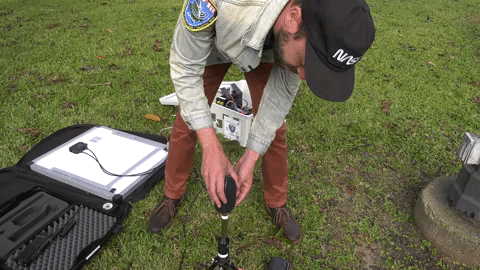
We are working with Lockheed Martin in Palmdale, California, to manufacture the X-59 and are making significant progress, despite the pandemic.
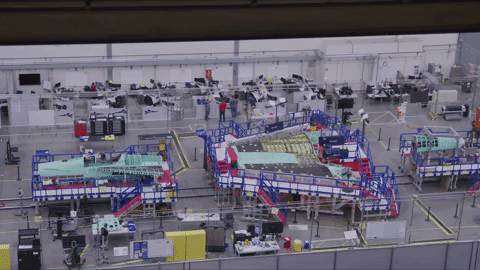
We finished the majority of work on the wing and closed its interior, marking the halfway point on construction of the aircraft.
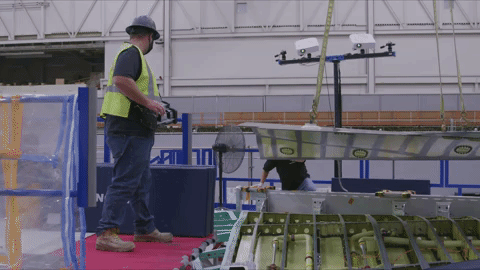
The X-59 team at Lockheed Martin completed the final touches by fastening skins to the wing. A special sealant is applied so that fuel can be carried in the wings of the aircraft.

Moving at a steady pace, technicians continue to work on many parts of the aircraft simultaneously. The forebody section of the aircraft will carry the pilot and all the avionics needed to fly the aircraft.
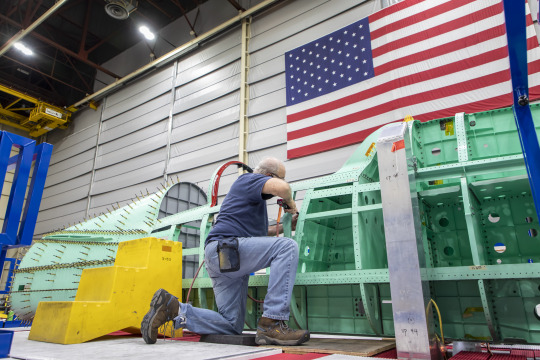
Because of the X-59’s long nose, the pilot will rely on an eXternal Vision System (XVS), rather than a window, for forward-facing visibility. The XVS will display fused images from an advanced computing system and cameras mounted on the upper and lower part of the aircraft’s nose.

The aft part of the aircraft will hold an F414 GE engine and other critical systems. Unlike typical aircraft, the engine inlet will be located on the upper surface of the X-59 and is one of many features that will help reduce the noise heard on the ground.
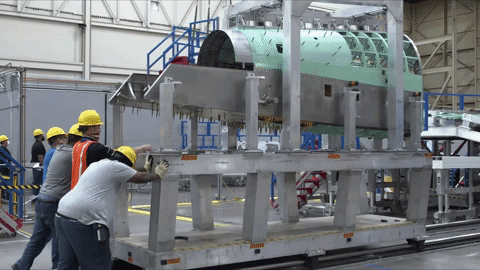
Over the next several months, the team will merge all three sections together. After final assembly in 2021, the X-59 will undergo numerous tests to ensure structural integrity of the aircraft and that ¬its components work properly. First flight of the aircraft will be in 2022 and community testing will start in 2024, making way for a new market of quiet commercial supersonic aircraft.

Want to learn more about the X-59 and our mission? Visit nasa.gov/X59.
Make sure to follow us on Tumblr for your regular dose of space: http://nasa.tumblr.com.
#NASA#aeronautics#X59#QueSST#supersonic#Quiet SuperSonic Technology#commercial aircraft#airplane#planes#flying#aero
1K notes
·
View notes